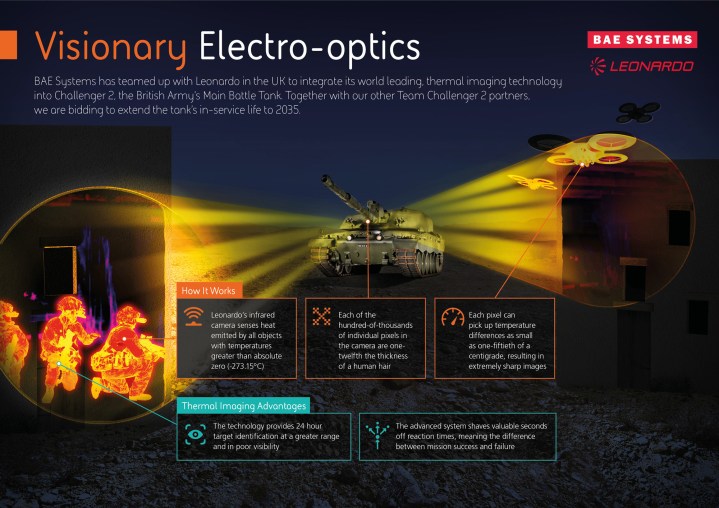
The British Army’s tanks are getting a tech upgrade — and it’s courtesy of some of the same gadgetry that previously helped bring David Attenborough’s jaw-dropping series of Planet Earth II wildlife documentaries to life.
Developed by the U.K.-based engineering company Leonardo as part of a bid by defense-focused multinational company BAE Systems, the new “electro-optic technology” is described as the most capable night vision tech on the market. Capable of sensing the heat emitted by all objects with temperatures in excess of absolute zero, the advanced thermal imaging technology can detect tiny temperature differences as small as 1/50th of a centigrade. The images produced are also impressively high resolution, with each pixel measuring just 1/12th the thickness of a human hair.
This results in some impressive visuals, as seen in Planet Earth II’s memorable scenes showing a leopard’s nocturnal hunt, right down to the movement of individual hairs on the animal’s body. The technology has also been used for sports broadcasting, assisting cricket umpires in telling whether a ball has hit the batsman, pad or ball by examining the temperature change caused by the friction of individual impacts.
In terms of military application, this tech could help shave seconds off reaction times in a hostile situation, something thatcould change the outcome of a skirmish involving tanks. Leonardo’s thermal imaging tech has already been proven in combat, when it helped Chinook Helicopters to fly undetected through mountain valleys in Afghanistan — even in poor weather conditions.
“The employment of Leonardo’s thermal imaging technology within the Challenger 2 Life Extension Program will ensure that the British Army’s Main Battle Tank will provide the crew with the best possible imaging capability,” Ray Hopkins, a vice president of systems engineering at Leonardo, told Digital Trends. “This will provide the crew with a 24-hour ability to detect, identify, and engage threats at longer ranges, with greater accuracy, in a solution that is supportable for the remaining operational life of the Main Battle Tank.”
The technology can be retrofitted onto existing tanks, thereby greatly enhancing their life span. This is different from some of the previous BAE Systems projects we’ve covered — which have tended to focus on more futuristic, long-term sci-fi technologies, such as drones that can be “grown” in vats of chemicals or submarines that can be piloted using virtual reality.


